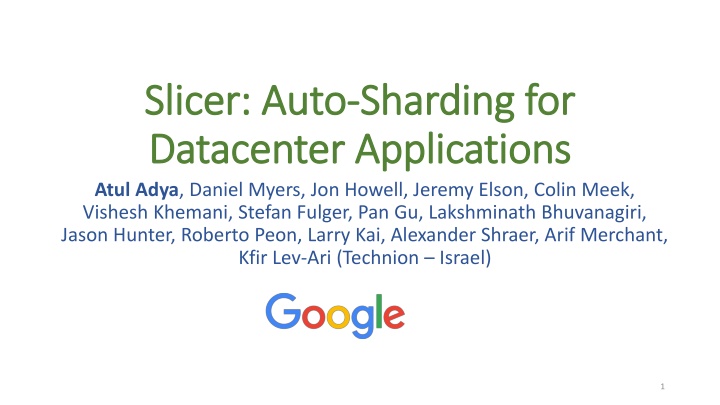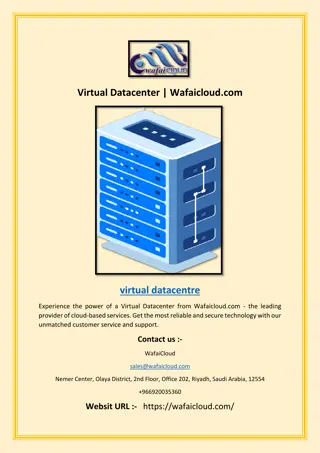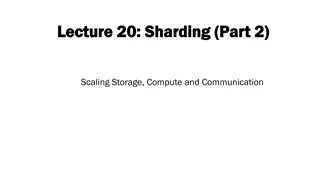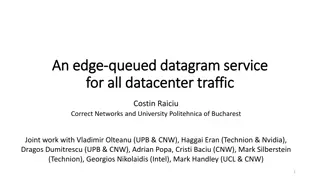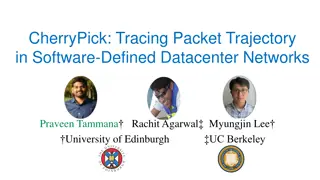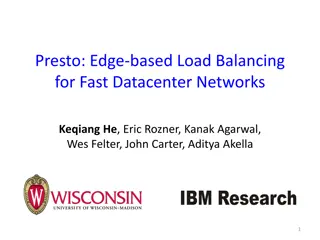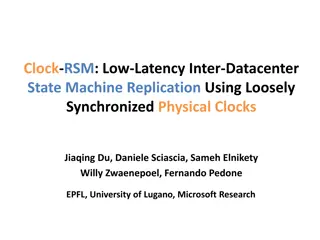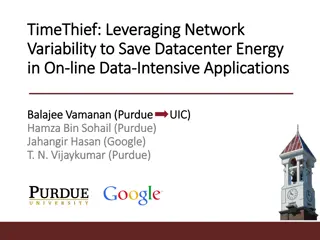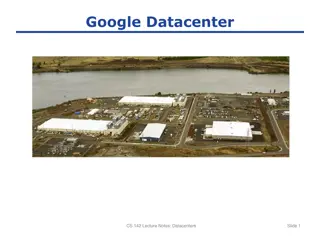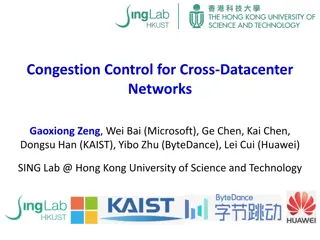Slicer: Auto Slicer - Sharding Datacenter Applications
Slicer simplifies building services leveraging local memory, enabling applications to utilize server machines' abundant memory efficiently. Explore how Slicer addresses challenges in stateful servers, DNS service scalability, and server replication strategies.
Download Presentation

Please find below an Image/Link to download the presentation.
The content on the website is provided AS IS for your information and personal use only. It may not be sold, licensed, or shared on other websites without obtaining consent from the author.If you encounter any issues during the download, it is possible that the publisher has removed the file from their server.
You are allowed to download the files provided on this website for personal or commercial use, subject to the condition that they are used lawfully. All files are the property of their respective owners.
The content on the website is provided AS IS for your information and personal use only. It may not be sold, licensed, or shared on other websites without obtaining consent from the author.
E N D
Presentation Transcript
Slicer: Auto Slicer: Auto- -Sharding Datacenter Applications Datacenter Applications Atul Adya, Daniel Myers, Jon Howell, Jeremy Elson, Colin Meek, Vishesh Khemani, Stefan Fulger, Pan Gu, Lakshminath Bhuvanagiri, Jason Hunter, Roberto Peon, Larry Kai, Alexander Shraer, Arif Merchant, Kfir Lev-Ari (Technion Israel) Sharding for for 1
Local Memory Considered Helpful Local Memory Considered Helpful Server machines have a lot of memory Applications should take advantage of it, e.g., caching Datacenter applications often don t cache data Too hard to implement Slicer makes it easy to build services that use local memory 2
Talk Outline Talk Outline Why stateful servers are difficult Slicer model and architecture Evaluation 3
Building a DNS Service Building a DNS Service End-user devices Virtual Machines DNS Service Cloud Platform DNS service needs to be scalable and fast! 4 4
Full State Replicated on Every Server Full State Replicated on Every Server End-user devices Any server can handle any request Easy adaptation to failures, capacity changes, load skews Hard to scale or handle mutations Frontends DNS Servers 5
Stateless: Interchangeable Servers + Database Stateless: Interchangeable Servers + Database End-user devices Any server can handle a request Cannot query DB for every DNS request High latency Network hop and marshaling costs Frontends DNS Servers Database 6
Stateful: Static Sharding Stateful: Static Sharding Hash(key) mod 4 Hash(key) mod 4 Frontends DNS servers Simple mapping from keys to servers via static function Failure adaptation: Black-hole traffic for crashed server Capacity adaptation: Could result in significant key churn 7
Stateful: Consistent Hashing Stateful: Consistent Hashing ConsistentHash(key) ConsistentHash(key) Frontends DNS servers Implement server presence detection Addresses capacity and failure adaptation, key churn Stochastic load balancing is inadequate Distributed decisions harm affinity 8
Stateful: Central Controller Stateful: Central Controller Hash(key) Hash(key) Hash(key) Frontends Controller Storage Master Application servers servers Tablet Central server: presence detection, load monitoring, consistent view Fan-out assignments to large number of clients and servers Internals of a sharded distributed storage system! Should we use stateless servers? 9
Slicer: Refactored System for Sharded Apps Slicer: Refactored System for Sharded Apps Provides auto-sharding without tying to storage Separate assignment generation control plane from request forwarding data plane Via a small interface In a scalable, consistent, fault-tolerant manner Reshards for capacity and failure adaptation, load balancing Evaluated Slicer in production deployment 10
Benefits of Sharding/Affinity Benefits of Sharding/Affinity Any type of serving from memory / caching E.g., Cloud DNS Even stateless services use stateful components E.g. External caches such as Memcache Affinity helps aggregating writes to storage E.g., Thialfi [SOSP 11] batches notification messages to storage 11
Slicer Sharding Model Slicer Sharding Model Application servers Hash keys into 63-bit space Assign ranges ("slices") of space to servers Hash(K1) Hash(K2) Hash(K3) Split/Merge/Migrate slices for load balancing Asymmetric replication : more copies for hot slices 0 263 - 1 Slices 12
Slicer Architecture: Goals Slicer Architecture: Goals High-quality sharding and consistency of a centralized system Low latency and high availability of local decisions 13
Slicer Overview Slicer Overview Distributed data plane Centralized control plane Hash(key) Hash(key) Frontends Clerk Slicelet Application servers Slicer Service 14
Slicer Architecture Slicer Architecture Frontends Clerk Backup Distributor Slicelet Application servers Assigner Distributor Existing Google Infrastructure Lease Manager Load Capacity Monitoring Health Monitoring Monitoring 15
Tolerating Failures Tolerating Failures Two types of failures: Localized failures: machine failures or datacenter offline Correlated failures: whole service such as Assigner or Distributor being down due to, e.g., Bad configuration push Software bug Bug in underlying dependencies 16
Tolerating Localized and Correlated Failures Tolerating Localized and Correlated Failures Frontends Distributor datacenters Application servers Smaller/Simpler Components More Complex Components Backup Distributor datacenters Assigner datacenters 17
Slicer Features and Evaluation Slicer Features and Evaluation Load balancing algorithm Assignments with strong consistency guarantees Production Measurements scale, load balancing, availability, Comparison with consistent hashing Experiments Comparing load balancing strategies Load reaction time Assigner recovery time assignment latencies Detailed Brief 18
Evaluation: Slicer Usage Evaluation: Slicer Usage Slicer load balances a few million RPS for several Google services 99.98% of clients requests had a valid assignment < 0.01% of these requests directed to the wrong server 19
Evaluation: Load Balancing Effectiveness Evaluation: Load Balancing Effectiveness Slicer allows tighter capacity allocation by reducing skew 20
Summary: Slicer makes Stateful Services Practical Summary: Slicer makes Stateful Services Practical Reshards in the presence of capacity changes, failures, load skews Scalable and fault-tolerant architecture Separates assignment generation control plane from request forwarding data plane Evaluated Slicer in production deployment 21
